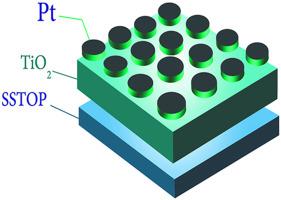当前位置:
X-MOL 学术
›
Ceram. Int.
›
论文详情
Our official English website, www.x-mol.net, welcomes your
feedback! (Note: you will need to create a separate account there.)
Growth of amorphous, anatase and rutile phase TiO2 thin films on Pt/TiO2/SiO2/Si (SSTOP) substrate for resistive random access memory (ReRAM) device application
Ceramics International ( IF 5.1 ) Pub Date : 2020-07-01 , DOI: 10.1016/j.ceramint.2020.03.188 Mabkhoot A. Alsaiari , Nabil A. Alhemiary , Ahmad Umar , Brian E. Hayden
Ceramics International ( IF 5.1 ) Pub Date : 2020-07-01 , DOI: 10.1016/j.ceramint.2020.03.188 Mabkhoot A. Alsaiari , Nabil A. Alhemiary , Ahmad Umar , Brian E. Hayden

|
Abstract Memory structures play a basic role in providing integrated circuits of powerful processing capabilities. Even most powerful processors have nothing to offer without an accompanying memory and importantly, the development of mobile devices is dependent on the continual improvement of memory technology. Herein, we report the synthesis of TiO2 thin films on SSTOP (Pt/TiO2/SiO2/Si) substrate via physical vapour deposition process for the first time. The layers consisted of Si, SiO2, TiO2 and Pt, hence the SSTOP shorthand is used throughout the text. Three different phases of TiO2 thin films were obtained, i.e. amorphous, anatase and rutile phases, by controlling the reaction parameters which were examined by x-ray diffraction (XRD), scanning electron microscopy (SEM), energy dispersive spectroscopy (EDS), atomic force microscopy (AFM) and Raman-scattering spectroscopy in order to understand the crystallographic, morphological, compositional and scattering properties. The detailed studies confirmed the formation of various crystal phases of titania. The grown thin films on SSTOP substrates were further utilized to fabricate resistive random access memory (ReRAM) devices and the initial electrical screening was performed on capacitor-like structures which were prepared using platinum top electrodes (diameter = 250 μm) on a 14 × 14 array metal contact mask. Current-Voltage (I–V) measurements were implemented employing a range of current compliances (IC). The detailed electrical characterizations revealed that the forming field for a switchable unipolar device was found to be greatest on rutile titania and lowest on the amorphous titania phase. Similarity, the resistive contrast was greatest on the rutile titania phase and lowest on the anatase titania phase.
中文翻译:

在 Pt/TiO2/SiO2/Si (SSTOP) 衬底上生长非晶、锐钛矿和金红石相 TiO2 薄膜,用于电阻随机存取存储器 (ReRAM) 器件应用
摘要 存储器结构在提供强大处理能力的集成电路方面发挥着基本作用。即使是最强大的处理器,如果没有附带的内存,也无法提供任何功能,重要的是,移动设备的发展依赖于内存技术的不断改进。在此,我们首次报道了通过物理气相沉积工艺在 SSTOP (Pt/TiO2/SiO2/Si) 衬底上合成 TiO2 薄膜。这些层由 Si、SiO2、TiO2 和 Pt 组成,因此在整个文本中使用 SSTOP 速记。通过控制反应参数,得到了 TiO2 薄膜的三种不同相,即非晶相、锐钛矿相和金红石相,通过 X 射线衍射 (XRD)、扫描电子显微镜 (SEM)、能量色散谱 (EDS)、原子力显微镜 (AFM) 和拉曼散射光谱,以了解晶体学、形态学、成分和散射特性。详细的研究证实了二氧化钛的各种晶相的形成。在 SSTOP 衬底上生长的薄膜进一步用于制造电阻随机存取存储器 (ReRAM) 器件,并在使用铂顶部电极(直径 = 250 μm)在 14 × 14阵列金属接触掩模。电流-电压 (I–V) 测量采用一系列电流顺应性 (IC) 进行。详细的电气特性表明,发现可切换单极器件的成形场在金红石二氧化钛上最大,在无定形二氧化钛相上最小。
更新日期:2020-07-01
中文翻译:

在 Pt/TiO2/SiO2/Si (SSTOP) 衬底上生长非晶、锐钛矿和金红石相 TiO2 薄膜,用于电阻随机存取存储器 (ReRAM) 器件应用
摘要 存储器结构在提供强大处理能力的集成电路方面发挥着基本作用。即使是最强大的处理器,如果没有附带的内存,也无法提供任何功能,重要的是,移动设备的发展依赖于内存技术的不断改进。在此,我们首次报道了通过物理气相沉积工艺在 SSTOP (Pt/TiO2/SiO2/Si) 衬底上合成 TiO2 薄膜。这些层由 Si、SiO2、TiO2 和 Pt 组成,因此在整个文本中使用 SSTOP 速记。通过控制反应参数,得到了 TiO2 薄膜的三种不同相,即非晶相、锐钛矿相和金红石相,通过 X 射线衍射 (XRD)、扫描电子显微镜 (SEM)、能量色散谱 (EDS)、原子力显微镜 (AFM) 和拉曼散射光谱,以了解晶体学、形态学、成分和散射特性。详细的研究证实了二氧化钛的各种晶相的形成。在 SSTOP 衬底上生长的薄膜进一步用于制造电阻随机存取存储器 (ReRAM) 器件,并在使用铂顶部电极(直径 = 250 μm)在 14 × 14阵列金属接触掩模。电流-电压 (I–V) 测量采用一系列电流顺应性 (IC) 进行。详细的电气特性表明,发现可切换单极器件的成形场在金红石二氧化钛上最大,在无定形二氧化钛相上最小。











































 京公网安备 11010802027423号
京公网安备 11010802027423号